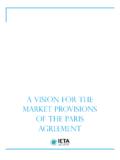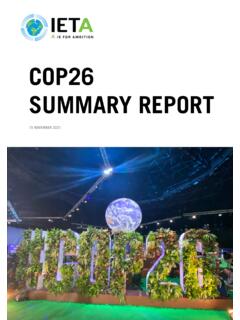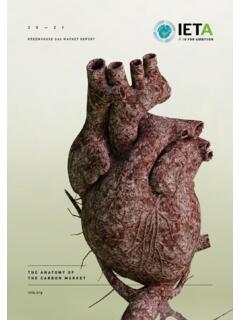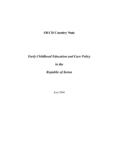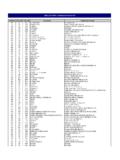Transcription of REPUBLIC OF KOREA: AN EMISSIONS TRADING …
1 REPUBLIC OF korea : AN EMISSIONS TRADING CASE STUDY2 REPUBLIC of KoreaThe World s Carbon Markets: A Case Study Guide for PractitionersLast Updated: September 2016As part of the 2009 Copenhagen Accord, the REPUBLIC of korea pledged to reduce GHG EMISSIONS 30% below its Business As Usual (BAU) level by 2020, a goal that equates to a 4% reduction below 2005 major step towards this goal was realized in April 2010, when the Framework Act on Low Carbon Green Growth (Framework Act) and the Presidential Decree promulgated thereunder came into effect.
2 The three most important features of the Framework Act are that it:1. sets the national GHG emission target to reduce EMISSIONS 30% below BAU levels by 2020;2. establishes the Greenhouse Gas Target Management System (TMS), which sets EMISSIONS and energy targets for business entities in the industrial, power generation, transportation, building, agriculture, food and waste sectors; and;3. provides the legal basis for an EMISSIONS TRADING Scheme (ETS).However, the REPUBLIC of korea renounced the national GHG emission target described above by the June 2016 amendment to the Presidential Decree to the Framework Act.
3 The amended Presidential Decree to the Framework Act replaced the previous target with a new target: to reduce 37% below BAU levels by 2030. Among the 37% reductions to be made, the Korean government plans to reduce through domestic reductions, and through the international carbon market. Details on how the Korean government will procure carbon credits or other similar reductions through international carbon market have not yet been determined. As further described below, changes to the national GHG emission target may accompany changes to the REPUBLIC of korea s Phase I National Allowance Allocation Act on Allocation and TRADING of Greenhouse Gas EMISSIONS Allowances (ETS Act) and the Presidential Decree promulgated thereunder were enacted on November 15, 2012, introducing a national EMISSIONS TRADING (cap-and-trade) system that began on January 1, 2015.
4 The Master Plan for the EMISSIONS TRADING Scheme and the Phase I National Allowances Allocation Plan were announced in 2014 in order to implement the ETS the commencement of the Korean EMISSIONS TRADING System (K-ETS) in 2015, the REPUBLIC of korea has become the second nation in Asia to introduce a nationwide cap-and-trade system. Approximately 530 business entities are subject to caps under the K-ETS. For Phase I (2015~2017), 100% of the allowances have been allocated for free, and in Phase II (2018~2020), 97% of the allowances will be allocated for 1: korea ETS Governance3 Before June 2016, the Ministry of Environment was in charge of the implementation of the K-ETS, with some supervision by the Ministry of Strategy and Finance.
5 However, with the recent amendment to the ETS Act, the Ministry of Environment s authority in implementing the K-ETS has been distributed to four different ministries: (i) the Ministry of Trade, Industry and Energy, which oversees industrial and power generation EMISSIONS ; (ii) the Ministry of Environment, which oversees waste related EMISSIONS ; (iii) the Ministry of Land and Infrastructure Transport, which oversees transportation and construction sector EMISSIONS ; and (iv) the Ministry of Agriculture, Food and Rural Affairs, which oversees agricultural and food sector of the REPUBLIC of korea 's 2016 Climate Change Response System4 Sectors that meet one of the following conditions may receive 100% of their allowances for free in a certain phase.
6 1. sectors whose production cost rate (ratio of total allowance cost among total value added production, specifically defined in the Presidential Decree to ETS Act) is 30% or more; Carbon Leakage ProvisionsTo reduce 37% below the REPUBLIC of korea s BAU emission levels by Reduction Goal 539 million tCO2e in 2015 CapCarbon Dioxide (CO2), Methane (CH4), Nitrous Oxide (N2O), Hydrofluorocar-bons (HFC), Perfluorocarbons (PFC), and Sulfur hexafluoride (SF6)Approximately 530 companies The industry, power generation & energy, building, transportation and waste sectors are covered, which are further divided into 23 sub-sectorsThe K-ETS has three phases.
7 Phase I (2015-17), Phase II (2018-20), and Phase III (2021-25).Companies whose total annual EMISSIONS are 125,000 tCO2e or more or companies with places of business whose annual EMISSIONS are 25,000 tCO2e or more are subject to caps under the K-ETS. Companies whose EMISSIONS are below the threshold described above may voluntarily participate in the Gases CoveredNumber of Obligated Entities Sectors CoveredCompliance PeriodsThresholdKorea Allowance Unit (KAU): KAUs are allowances allocated to companies subject to targets under the K-ETSK orea Offset Credit (KOC): KOCs are credits converted from CERs or other offsets approved by the Korean government.
8 KOCs can be traded between both ETS and non-ETS entities, but cannot be traded in the KRX. KOCs cannot be submitted to the government for compliance with K-ETS Credit Unit (KCU): KCUs are credits converted from KOCs. KOCs can be submitted to the Korean government for compliance with K-ETS targets. KOCs can be claimed and traded between ETS entities only, and are allowed to be traded in the KRX. KCUs cannot be converted back to KOCs. According to monthly price updates provided by the Climate Change Research Institution of korea , the average closing price of KAU15s traded in the korea Exchange (KRX) during the period between January, 2015 and June 2016, was KRW 16,520/tCO2e.
9 KAU15 prices were at its highest on May 19, 2016, reaching KRW 21,000 to monthly price updates provided by the Climate Change Research Institution of korea , the average closing price of KCU15s traded in the KRX during the period between January, 2015 and June 2016, was KRW 18,500/tCO2e. KCU15 prices were at its highest on June 7, 2016, reaching KRW 18,500 Phase I, 100% of allowances have been freely allocated. In Phase II, 97% of allowances will be freely allocated; and in Phase III 90% or less allowances will be freely allocated.
10 Allowances are grandfathered, except for three sectors (aviation, cement and oil-refinery) which receive allowances based on are subject to different reduction factors depending on the sector it is in ( , sectoral targeting). The government sets sector-wide caps, and the reduction factor applicable to companies within such sector is the ratio of the sector-wide cap and the number of allowances companies within such sector has applied for. Types of Credits AvailableAverage Carbon PriceAllowances AllocationSummary of Key Policy Features52.
